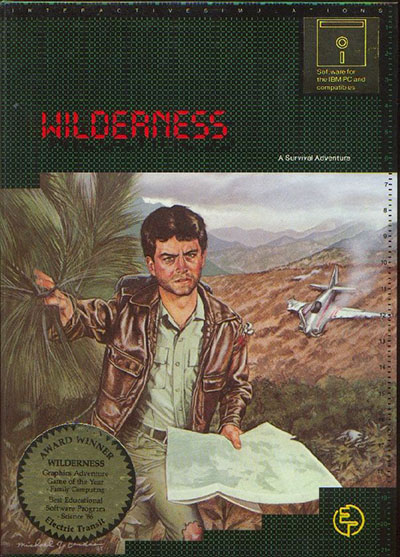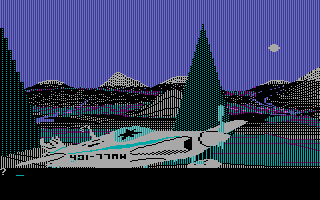In the 21st century, game companies are expanding what can be done with 3D interactive tools and virtual spaces. Companies like Epic Games are increasing blurring the lines between industries as diverse as simulation, film production, and a wide range of XR experiences (virtual reality, mixed reality, and augmented reality). In a recent example, an estimated 10.7 million people simultaneously logged on to Epic’s Fortnite for a live, in-game music experience(1).
Over 30 years ago, the game industry was in its infancy, the Apple II personal computer had been introduced with little available software, and motivated people wrote their own programs. In 1986, a small Los Angeles game publisher called Electric Transit, Inc. released one of the first 3D games designed for a personal computer. Wilderness: A Survival Adventure, was a first-person, simulation/resource management game that could run under DOS or on an Apple II.

Cover art for Wilderness: A Survival Adventure, published by Electric Transit [image courtesy of mobygames.com]
A Physical Place to Exchange Virtual Experiences
Around 20 miles from JPL, a computer store called Rainbow Computing, established in 1976, had become a meeting place for people interested in exploring what the new personal computers could do. Local gamers and game designers came to socialize, to buy a game, or to sell one they had created. David Mullich, now a game designer and academic, was a student working at the store part-time, and remembers the informality of early game production. People would create their own games, and bring them into the store, “…and we’d go and Xerox the documentation and put in a person’s cassette tape that we stored programs on… We copied their games, or their other products, put them in a Ziploc bag and put them on a pegboard on the wall. And that’s how… computer software was sold originally, to the home market.”(2)
One Rainbow customer was Sherwin Steffin, founder of a local educational software company called Edu-Ware. Impressed by Mullich’s game-writing skills, he hired him away from Rainbow. Around 1981 Huntress approached Edu-Ware with a game he had written in his spare time, a space shuttle simulation. Edu-Ware released the game as Rendezvous: A Space Shuttle Simulator, and Mullich wrote the documentation, how the controls worked, and how to use it in a classroom. He notes that, “I put it all in NASA language, so it looked like a flight operations manual,” enhancing the perception of entering the virtual space of the shuttle(3).
About a year later, Huntress returned with another idea, a game that would test players’ abilities to survive a plane crash in a remote wilderness. He and his new collaborator Kohlhase, had programmed and designed the game, incorporating science-based techniques for surviving hypothermia, starvation and other wilderness hazards. The game, written in assembly language, used randomly-generated 3D terrain maps to create the game spaces. Graphic elements, including animals, trees and game objects, were 2D representations created by entering values for tones and colors into a grid. The game also had a natural language element. Players typed commands into the game, which recognized 300 nouns and verbs controlling navigation and actions including camping, using weapons, equipment and supplies and preparing food. For Kohlhase, active in the Sierra Club, it may have been a chance to promote wilderness appreciation and skills. For Huntress, the planetary chemist, the challenge of simulating and programming an earthly world may have drawn him in.

Wilderness Survival screenshot of the game terrain [image courtesy of mobygames.com].

Game algorithms used player data to calculate health and survival in the game [image courtesy of mobygames.com].
Survival in the Game Wilderness
Though their games sold moderately well, Edu-Ware struggled, and the company was bought by Management Services America (MSA), which made accounting software. Peachtree Software, another MSA subsidiary, was put in charge of marketing the games. It was an uncomfortable fit for Steffin, Mullich and Huntress, who left with marketing executive Pamela Pollock to form their own company, Electric Transit in 1985. They bought the rights to Wilderness and published it in 1986. After a brief partnership with Electronic Arts for distribution, and another partnership with Spectrum Holobyte, Electric Transit closed their doors in 1987. Their competitors in the rapidly-evolving game landscape included popular fantasy role-playing games such as the Wizardry and Ultima series, both released in 1981, which continued to thrive. After the demise of Electric Transit, the scientists continued their work in space science, with Huntress eventually becoming NASA’s Associate Administrator for Space Science in Washington, D.C., while Kohlhase remained at JPL until his retirement. Mullich, now at the Art Center College of Design, is the only one of the three who has continued his work in the game industry, creating games, teaching games and writing about their unexpected histories.
Conclusions
Navigating simulated spaces and experiences has become a normal part of the cultural and technological landscape for game players and also for architects, automotive designers, simulation designers, artists and interactive event creators, among many other fields. Interleaving simulation and storytelling with game creation tools is an increasingly interesting challenge for developers, who have also struggled to break free from problematic portrayals of race, gender and culture in the persuasive and compelling worlds they create. The early exchange of ideas in physical spaces and embedded in the virtual spaces of Space Shuttle Simulator and Wilderness 30 years ago—that players could virtually travel through space, navigate a spacecraft or survive in a virtual wilderness—have shaped our current media environment in ways that are still not completely understood. As anthropologists and historians, it calls us to explore both the physical and virtual contours of creative work, no matter how ephemeral, and the unexpected collaborations they reveal.
Notes
(1) Marshmello played on February 2, 2019 in-game, https://www.theverge.com/2019/2/2/18208223/fortnite-epic-games-marshmello-concert-exciting-bizarre-future-music
(2) Author’s interview with David Mullich, September 2019.
(3) ibid.
(4) ibid.
Sources
https://www.mobygames.com/game/wilderness-a-survival-adventure
Van Burnham, Supercade: A Visual History of the Videogame Age 1971-1984 (Cambridge, MA: The MIT Press, 2003, 2001)
